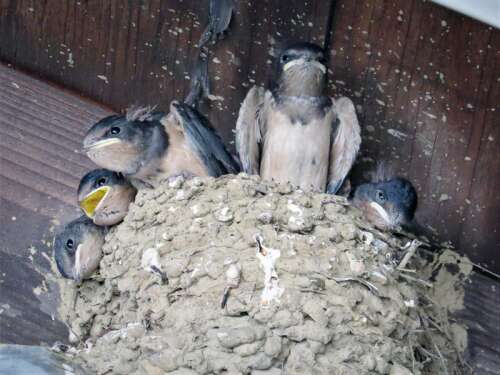Published June 19. 2021 06:37AM
his past week while mowing with my garden tractor I was witness to a feeding frenzy. This wasn’t a scene from “Jaws.”
Actually I was watching barn and tree swallows snatching flying insects from the air.
The mowing back and forth across that field was chasing small moths and some other unidentified winged insects from the grass, and once one swallow found the flying morsels, the word was out.
Within about 20 minutes, at least a half-dozen barn swallows and a few tree swallows were grabbing food for their nestlings. I’m sure when the local farmers are cutting hay, they too are joined by these helpful birds.
In our local forests and woodlots many bird species are adapted for snatching up flying “bugs.” Gnats that are so pesty buzzing all around our eyes and ears, are the favorite food for blue-gray gnatcatchers. These diminutive birds are constantly darting from a limb, snatching a gnat from midair, and 5 seconds later repeating this.
I keep wondering how many gnats are needed to support all the gnatcatcher activity but it must be enough. Also joining gnatcatchers in the forest understory are great-crested flycatchers, least flycatchers, eastern peewees and a few warbler species. These all specialize in catching the flying “bugs.”
Phoebes and cedar waxwings prefer feeding near streams where they catch emerging mayflies and their kin. While fly-fishing the Pohopoco Creek a few years ago, I watched about a dozen cedar waxwings darting from their streamside perches, fly just above the water, grab an insect and back to their perches. There were waxwings in the air every moment and not surprisingly, I missed a few trout rising for my dry fly as I was busy watching all that activity.
Flying above ponds, streams, and even fields or your backyards are a variety of dragonflies. They too are our allies, helping to control flying pests. If you were an insect, you would need “eyes in the back of your head” to avoid all that are looking for a tasty meal. We are not insects, but you can take a walk through “your nature area” and see all this activity for yourself. Get out there. …
Test Your Outdoor Knowledge: True or False: All birds that eat insects in the warmer months continue to eat only insects when they travel to their overwintering areas in the tropics or areas to our south.
Last Week’s Trivia Answer: Water striders (misnamed water spiders) have six legs and are insects, not spiders.
Contact Barry Reed at breed71@gmail.com.
Left: With a nest full of hungry nestlings, try to imagine how many insects the barn swallows catch in a day to feed that brood and themselves.
Right: This eastern phoebe was nesting under a bridge along Wiild Creek and was feasting on moths and emerging insects from near the stream.
Those folks casting their dry flies over the next month or two should be looking for cedar waxwings darting across the water snatching insects there.
Tree swallows, our earliest arriving swallow species, will finish nesting and leave our area about July 8, but not before feasting on thousands of flying insects in your backyards.
Look for redstarts, a warbler species, flitting from branch to branch snatching gnats and mosquitoes. They usually nest in damp areas, particularly near small mountain creeks.
The sleek barn swallows can be seen coursing across hay fields feasting on insects, look for their feeding frenzies when Troxell’s or Gaston’s farms begin cutting their hay fields.
Not all insect eaters are birds. The common whitetail dragonfly patrols fields and streamsides, snatching small insects all day long. BARRY REED/SPECIAL TO THE TIMES NEWS
Usually perched on a post, fence or low shrub, kingbirds dart from their perch, grab a “bug” and return to the same perch time and time again.
Above: Nesting in abandoned woodpecker holes, the great crested flycatcher is one of our forest-dwelling insect catchers.
Above: Nesting in abandoned woodpecker holes, the great crested flycatcher is one of our forest-dwelling insect catchers.
Probably the smallest ’empid’ (type of flycatcher species) is the least flycatcher, living in the understory of forests around our area.
Credit: Source link































